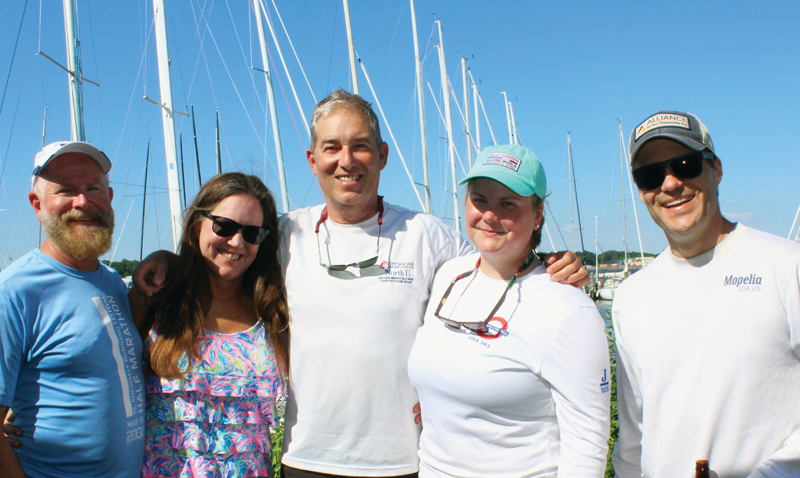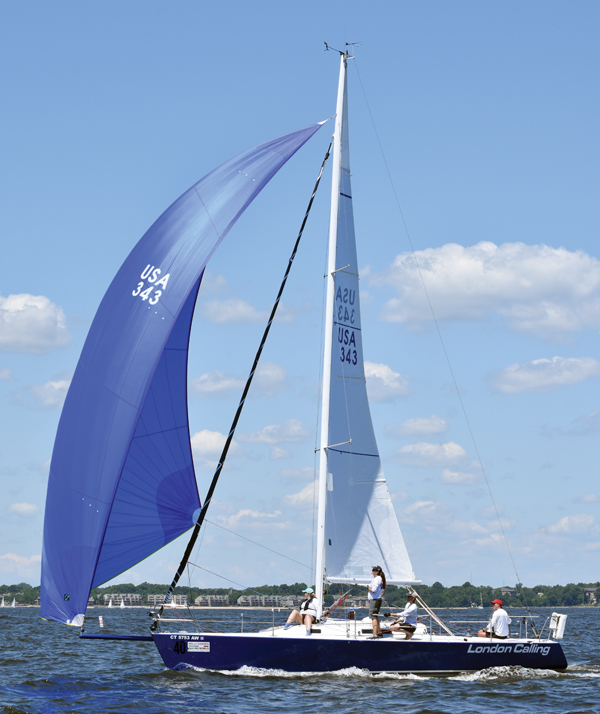The leap into sailing led to racing and a podcast.

A couple of classes and a lot of bravado…
Eventually, brimming with misplaced confidence with a couple of ASA (American Sailing Association) instructional courses under my belt, I went halves on a J/80 with my friend Erik, who with his patched sailing pants and extensive knowledge of sailing terms exuded an air of experience and insouciance. Our achievements mainly involved terrifying the rest of the fleet as we careened back and forth across San Francisco Bay, mostly out of control in the 25-knot breezes. I kept all this very quiet of course when I joined the Annapolis J/105 fleet last year.
My first experience of sailing, however, was as a nerdy teenager in an English coastal town, trying to emulate the cool kids by learning to windsurf in the slate-grey waters of Lyme Bay. That was back in the 1980s when every beach in Europe was a thicket of sails and boards and beautiful people. In our long summer vacations from university, we’d drive a van full of windsurfing gear to sunny Greece, teaching windsurfing to tourists and locals near the beautiful city of Thessaloniki. This was a life-changing experience for me, as was another summer spent working near Boston, which eventually led to me moving to the USA in my mid-20s.
Did you have any preconceived notions about sailing?
I probably assumed it would be easier and less complex than it actually is at a competitive level. Like most sports the basics are sort of straight-forward, but again like most sports you realize how much skill, commitment, and effort it takes to get anywhere near the front of the fleet. And, as a boat owner in a highly competitive fleet, a seemingly endless stream of financial investment… Thankfully my non-sailing but wonderful wife will probably never read this.

More laughs than should be legal.
I am quietly, but annoyingly, competitive. So right now, for me, it’s all about the racing. On London Calling we are setting ourselves a two-year plan to work our way up the J/105 fleet, which is obviously no easy task. It helps though to have a stellar core crew of Maura, Cynthia, Steve, Maggie, Jen, and Dan, all way better sailors than me, and who, in an act of either joint madness or charity (it surely wasn’t the appeal of the sandwiches between races), have agreed to crew for a second year. Seriously, we’ve gelled together well and had more laughs than we legally should. I basically do as I’m told; as Dawn Riley said, ‘the only thing you’re doing as a driver is slow the boat down.’
The thrill and agony of racing.
Prepare to be thrilled, humbled, and damp, in equal measure. Try racing. People always need crew: it’s basically bashing through chilly seas at roughly walking pace, dodging other boats with a fair amount of screaming and cursing at certain key points (not on our boat of course <insert smiley face>), and sometimes being thoroughly and systematically schooled in the art and science of racing by the leading boats, accompanied by grim-faced looks from your crew when your rushed gybe once again almost flung your bow people into the briney. But there are other times when it’s addictive: when you’re sweetly cutting through the water, edging ahead of a neighboring boat, confident you can make that top mark without tacking, with the sun out and a warm sea breeze flowing. And that $5000 you just spent on a new mainsail rather than food for your family suddenly seems, oddly, worth it.
The Sailfaster podcast.
I started my podcast, Sailfaster, last winter. Basically, I wanted to understand what the top sailors do differently. Of course, you soon learn that they don’t have any magic tricks or special buttons hidden in the tiller; they simply execute the fundamentals of boat handling, sail trimming, mark rounding, starting, leadership, and decision-making with the deftness and skill that comes from deep experience and a fair degree of obsessive attention to detail and preparation. There is much to learn from them!
Find the podcast by searching for ‘Sailfaster’ wherever you get your favorite podcasts.




